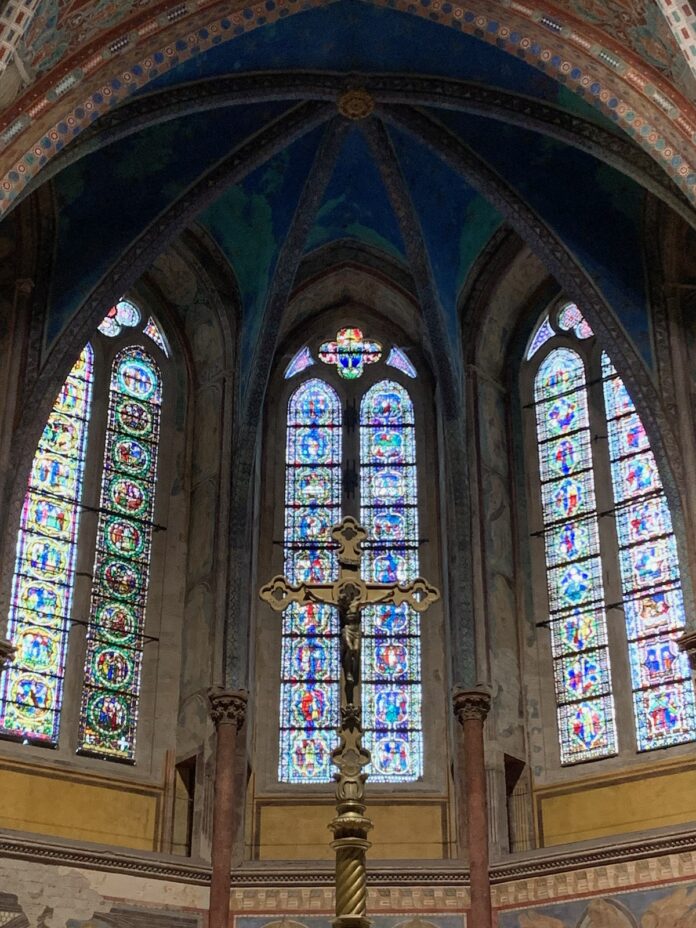The dilemma of Catholic aesthetics in contemporary media
In delving into the issue of the misuse and exploitation of Catholic aesthetics in secular media and art, it’s crucial to begin with a clear understanding of aesthetics and its historical origins.
The term “aesthetics” has its roots in the Ancient Greek word “aesthetikos,” which translates to “perceptive” or “sensitive to sensory perception.” Philosophers like Plato and Aristotle delved into discussions of beauty and the arts, setting the foundation for this concept. It was German philosopher Alexander Baumgarten who modernized the term “aesthetics,” defining it as the study of sensory perception and the appreciation of beauty.
Catholic aesthetics in particular involve the exploration of the visual, auditory and sensory elements within the Catholic tradition. It delves into the principles and values that inform the creation and appreciation of religiously significant works of art, as well as the embodiment of theological and spiritual concepts in various artistic forms within the context of the Catholic faith.
Unfortunately, in contemporary secular media, there is a prevalent trend of appropriating Catholic aesthetics without a genuine adherence to the theology or doctrines of Catholicism. This results in a misleading and sacrilegious representation of the Catholic faith. An illustrative instance of this is the music video for “Feather” by American pop singer Sabrina Carpenter, where immodest dancing took place on the altar of the historic Annunciation of the Blessed Virgin Mary Church in Brooklyn.
The church’s diocese claimed that the producers failed to accurately depict the full extent of the scenes in the documents provided in advance for permission to film in the church. While some might view it as a simple harmless catchy pop song, the disregard for the sanctity of the Catholic Church in the music video is a matter that cannot be overlooked. The inclusion of murders, suggestive dancing, and immodest attire within the holy setting is inappropriate.
Regrettably, this is not an isolated incident. Catholicism has been exploited sacrilegiously in the past for secular artistic visions. In Madonna’s 1989 music video for “Like a Prayer,” stigmata and burning crosses were depicted, a move that rightfully drew condemnation from the Vatican.
In 2018, the Met Gala’s theme was “Heavenly Bodies: Fashion and the Catholic Imagination.” While some argue that it was an appreciation of Catholic elements, outfits worn by celebrities can be seen as mocking the faith. For example, Rihanna’s pope-inspired attire and Jennifer Lopez’s cross-embellished gown were instances of appropriation.
Furthermore, it is essential to recognize that Christianity, and particularly Catholicism, often faces a distinct level of disrespect and religious appropriation in media representation, in contrast to how other religions like Islam and Buddhism are treated. This stark discrepancy underscores the necessity for a fair and respectful portrayal of religious traditions in the public sphere, which should include Catholicism.
To address these issues, there is a need for a more comprehensive evaluative framework for the use of Catholic aesthetics in secular media. This should consider factors such as the creator’s intentions, the contextual relevance and the impact on the audience.
Nevertheless, there is hope. Some practicing Catholics in Hollywood openly embrace their faith within their craft and share it unapologetically. In an interview with Sister Nancy Usselmann, FSP, director of the Pauline Center for Media Studies in Culver City, California, Mark Wahlberg emphasized the comfort and focus his faith provides, expressing his commitment to telling inspiring true stories, such as the movie about Father Stuart Long.
Documentarian Megan Harrington, director of “Pray: The Patrick Peyton Story,” also shared her faith’s foundational role in her work during an interview with Sr. Usselmann. Her film serves as a testament to the significance of the Eucharist, demonstrating how it sustains her as she showcases the mission of Father Peyton bridging Christ to the culture and forging connections with celebrities.
The appropriation of Catholic aesthetics for secular purposes has become an unsettling trend, casting shadows on the faith’s sanctity. Yet as we navigate this complex landscape, let the dedication of individuals who do integrate their faith into their work and inspire through their commitment. remind us of the potential for harmony between art and faith, the need for mutual respect in the ever-evolving realm of media and aesthetics, and more robust measures in order to portray religious traditions with utmost respect and fairness.
